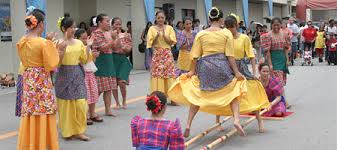Many of the Philippine dances is taken from European dances during the Spanish occupation. Pandango Sa Ilaw, Cariñosa, Rigodon and Balitao are dances for which the Filipinos are known. Outside the European tinged dances there are still own ethnic dances like the Tinikling, regional folk dances that are still done at festivals, fairs and fiestas.
Some examples of popular Philippine folk dances:
Pandanggo sa ilaw
 This is a mixture of grace and balance and comes from Lubang Island, Mindoro (Visayas). The term pandanggo is derived from the Spanish word fandango. It is stepped lively, waved and swinged in a varied rhythm (3/4). In this pandanggo 3 tinggoy (oil lamps) are used. One stands on the head and the other two each on a palm.
This is a mixture of grace and balance and comes from Lubang Island, Mindoro (Visayas). The term pandanggo is derived from the Spanish word fandango. It is stepped lively, waved and swinged in a varied rhythm (3/4). In this pandanggo 3 tinggoy (oil lamps) are used. One stands on the head and the other two each on a palm.
After a good catch celebrated fishermen of Lingayen with a party. They drank wine, danced and waved around with a lamp. This unique and colorful dance requires a lot of skill to keep the oil lamp on the head in balance and in the meantime to make circles with the arms holding in each hand a lighted lamp wrapped in transparent cloth or a fishing net. The waltz -like music seems like Pandanggo sa Ilaw.
Subli
The most popular dance in almost all barrios (small communities) of Buanan in Batangas. He is mainly danced in the month of May and during barrio fiestas, local annual festivities. It is performed as ceremonial dance in honor of the holy cross. (In the local dialect: Mahal Na Poong Santa Cruz). The dance originated 300 years ago in the barrio Dingin, Alitagtag in Batangas.
The name Subli is actually derived from the tagalog words subsub and bali. Subsub is bent (someone with an arched back) and bali is broken or crippled. The male dancers move throughout the dance crippled and bent back.
Tinikling
Tinikling as the national folk dance pre-emilently. Cross ahead of two kneeling helpers is a bamboo stick. On that, two long poles between them. The rhythm is indicated by beating the bamboo poles just above the ground against each other. Two dancers hop on the music back and forth between the poles.
The dance is originally from the province of Leyte and portrays the hopping of tikling birds. Dancers perform the dance with incredible grace and precision jumping between moving bamboo stakes.
